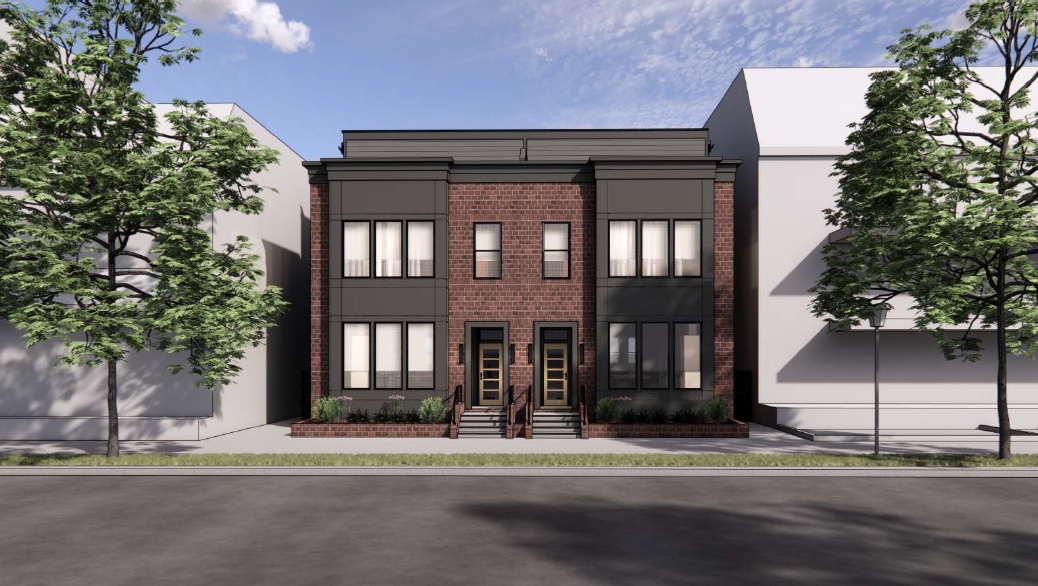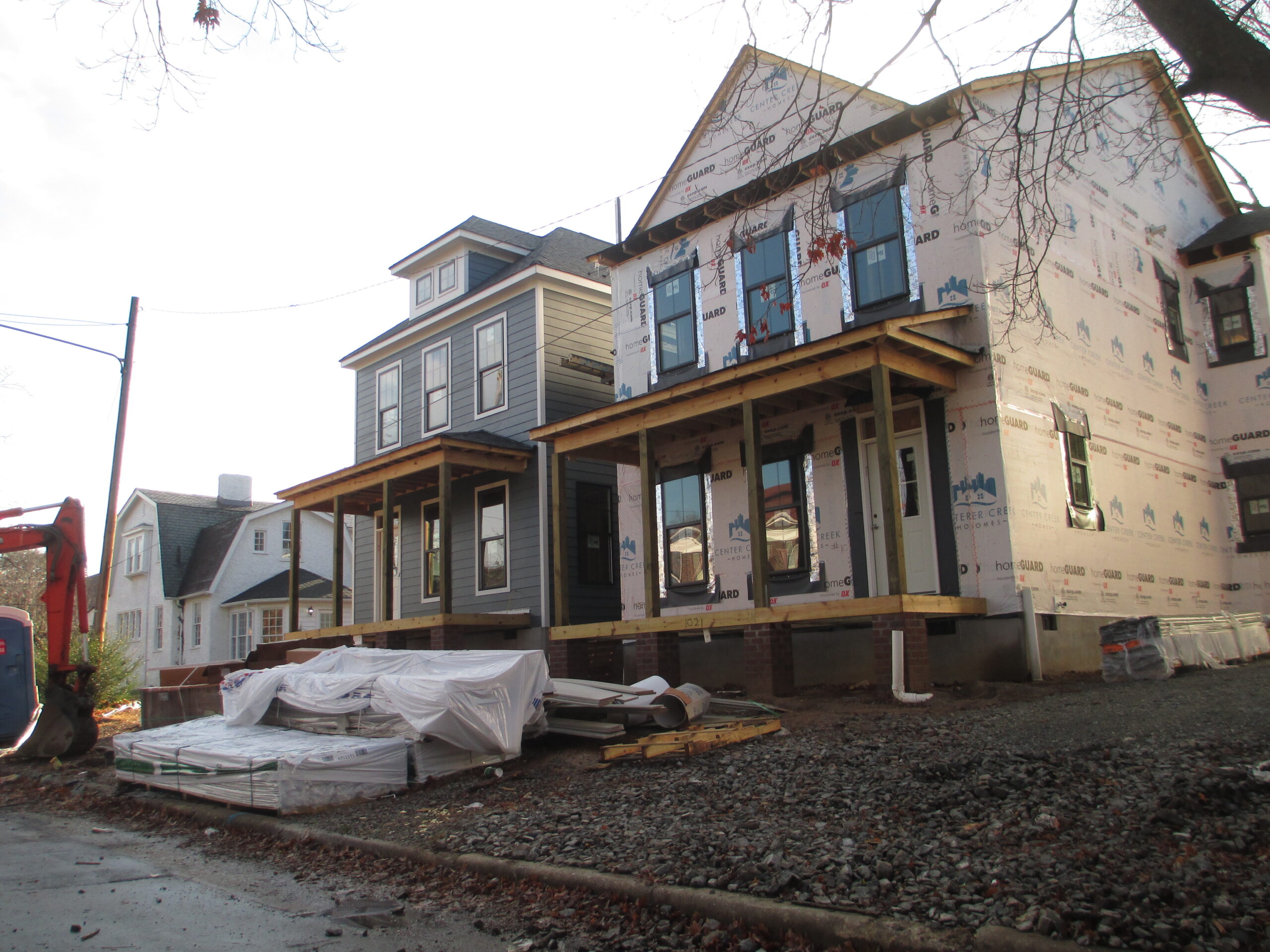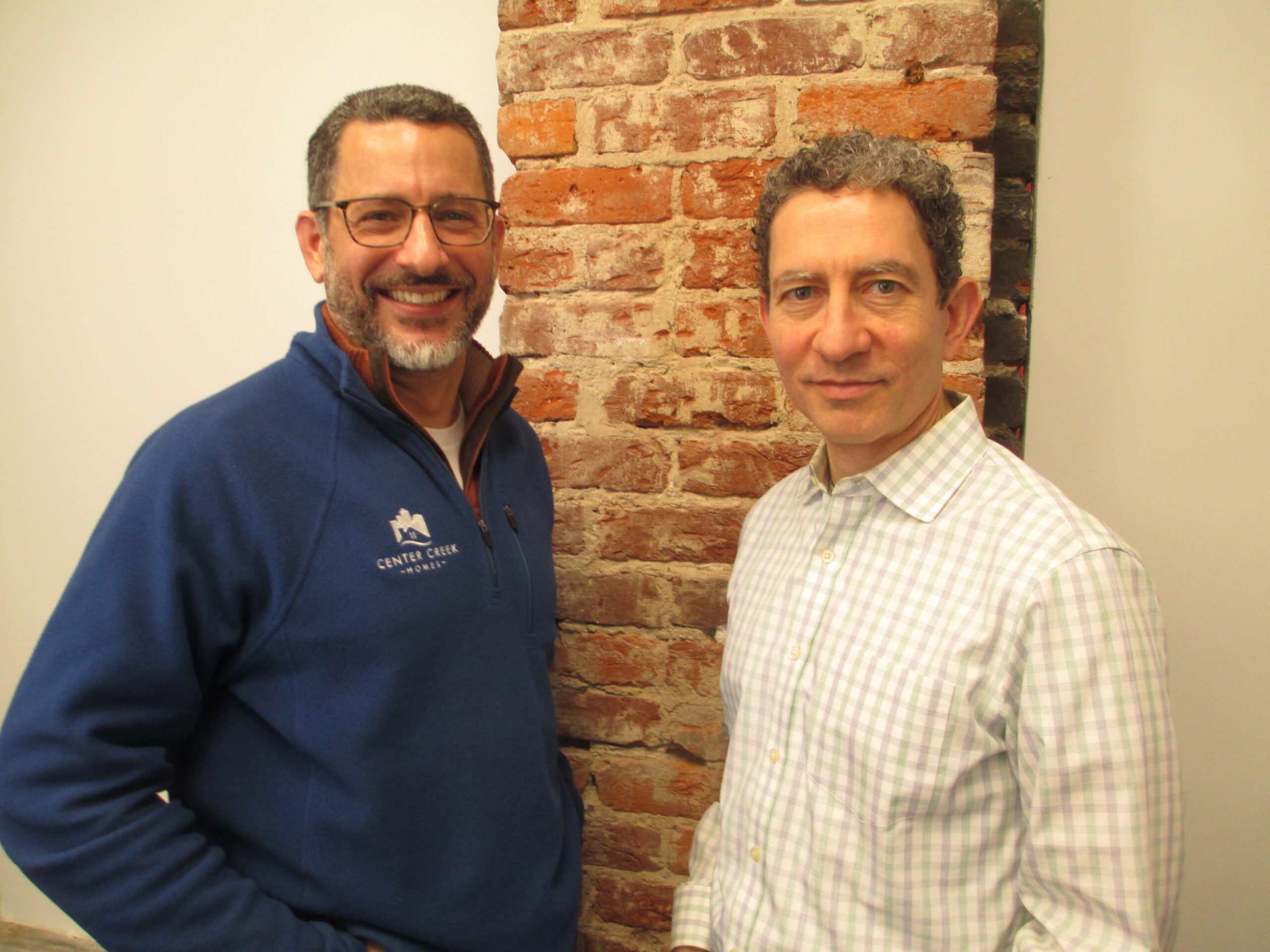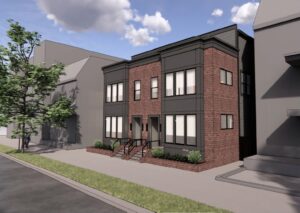
A rendering of the two townhomes planned to replace a parking lot at 415 N. Arthur Ashe Blvd. (Images courtesy of Center Creek Homes)
As it ups its workload across the city, a homebuilder known for lower-income housing is branching out into the higher-end market with a rare infill project along Arthur Ashe Boulevard.
Center Creek Homes, which has been increasing its local profile of late with new construction in Richmond’s Northside and West End, is looking to build two new attached homes on what’s now a parking lot at 415 N. Arthur Ashe Blvd., directly across from the Virginia Museum of History & Culture.
The three-story townhomes would feature a recessed top floor with a rooftop terrace overlooking the boulevard. Each totaling about 3,500 square feet, the homes would have four bedrooms and 3½ bathrooms and are planned to be priced at $1.2 million.
Center Creek principals Dan Magder and Greg Shron said the project came to them via Dave Seibert, a Long & Foster agent who lists many of their homes and saw the parking lot property listed for sale. Center Creek purchased the 0.18-acre lot in October for $700,000. The lot was assessed by the city at $377,000.
The property has been used as parking for the nearby three-story medical office building at 425 N. Arthur Ashe Blvd., which is also transitioning to residential use after a sale last summer.
An LLC tied to Peter Megyeri of Historic Richmond Renovations and Mark Kittrell, who has converted other buildings in the area, bought the office building and parking lot for $1.4 million in August. It quickly turned around and sold the parking portion to Center Creek two months later.
A zoning confirmation letter filed with the city describes a conversion of the building to seven residential units. Shron said the project would require less parking than the medical office use, freeing up the bulk of the parking lot for development.
“We jumped all over it,” Shron said of the parking lot, noting the scarcity of developable properties along that stretch of the boulevard. “The views out the front, across the street to the museum campus, are unmatchable.”
Shron, an architect and the company’s COO, said the project is designed to be in keeping with the architecture and scale of surrounding buildings, while also bringing something new to the neighborhood.
“The site is obviously unique. You do not come across a site like that very often,” he said. “It sits among a lot of very grand buildings with very noteworthy architecture, so the key on that site — like any site, maybe a little bit more challenging here — is to do something that feels at one with the surrounding context.”
Designed by Richmond architect Chris Wolf, the building would feature brick and HardiePlank siding on the exterior and an open floorplan on the first floor with living and dining rooms separated by the kitchen. Bedrooms would fill the top two floors, with a top-floor loft that could be used as a game room or additional bedroom.
Center Creek’s plans went before the city’s Commission of Architectural Review in December. Shron said the design would be reworked based on feedback received.
“It’s a marquee project for us,” said Magder, Center Creek’s CEO and a childhood friend of Shron. The pair launched the company in 2018 and has since built a sizable portfolio in Richmond, with about 80 homes sold so far and another 80 or so in various stages of development.
Backed by Magder’s real estate-focused private equity firm Center Creek Capital Group in Washington, D.C., Center Creek Homes started off locally focused on lower-income homes in the East End and Northside. Its earlier work included its five-home 20 & R project that’s now under construction, and a home it’s slated to build for local housing nonprofit Urban Hope.
It’s also been buying up homes in Richmond’s West End, including in the in-demand Libbie-and-Grove area, where it’s replaced older homes with larger new-construction, building those by-right, meaning within what’s allowed under existing zoning.
Another project in the Northside is fitting three new homes on a sizable residential lot at Chamberlayne and Rennie avenues. The previously half-acre lot fronting Chamberlayne was subdivided to create three smaller rear lots with the new homes fronting Rennie.

The company is building three new homes on Rennie Avenue in Northside behind an existing home fronting Chamberlayne Avenue.
Center Creek had purchased the larger Chamberlayne lot in 2019 for about $375,000 and sold the house on it last year for $309,000. The under-construction homes, at about 2,200 square feet with three bedrooms and three bathrooms, are being priced at just under $500,000.
While its Arthur Ashe Boulevard project and recent West End and Northside output are miles away from its previous work in terms of price points, Magder described them as a natural progression for the company as it expands in Richmond.
“Our bread-and-butter is still doing these entry-level and move-up homes, in Church Hill and Northside and Jackson Ward, and we saw an opportunity to do some work in the near West End,” Magder said.
“As we’re building out Center Creek Homes’ portfolio, we really like the fact that we have this diversity: a project like this (Arthur Ashe) in a prominent location, homes that empty-nesters and young families want to move into at Libbie and Grove, and we’re still doing the entry-level affordable and some deeply affordable houses in Jackson Ward and Church Hill. There are people of all sorts who want products of all sorts.”

A rendering of the two townhomes planned to replace a parking lot at 415 N. Arthur Ashe Blvd. (Images courtesy of Center Creek Homes)
As it ups its workload across the city, a homebuilder known for lower-income housing is branching out into the higher-end market with a rare infill project along Arthur Ashe Boulevard.
Center Creek Homes, which has been increasing its local profile of late with new construction in Richmond’s Northside and West End, is looking to build two new attached homes on what’s now a parking lot at 415 N. Arthur Ashe Blvd., directly across from the Virginia Museum of History & Culture.
The three-story townhomes would feature a recessed top floor with a rooftop terrace overlooking the boulevard. Each totaling about 3,500 square feet, the homes would have four bedrooms and 3½ bathrooms and are planned to be priced at $1.2 million.
Center Creek principals Dan Magder and Greg Shron said the project came to them via Dave Seibert, a Long & Foster agent who lists many of their homes and saw the parking lot property listed for sale. Center Creek purchased the 0.18-acre lot in October for $700,000. The lot was assessed by the city at $377,000.
The property has been used as parking for the nearby three-story medical office building at 425 N. Arthur Ashe Blvd., which is also transitioning to residential use after a sale last summer.
An LLC tied to Peter Megyeri of Historic Richmond Renovations and Mark Kittrell, who has converted other buildings in the area, bought the office building and parking lot for $1.4 million in August. It quickly turned around and sold the parking portion to Center Creek two months later.
A zoning confirmation letter filed with the city describes a conversion of the building to seven residential units. Shron said the project would require less parking than the medical office use, freeing up the bulk of the parking lot for development.
“We jumped all over it,” Shron said of the parking lot, noting the scarcity of developable properties along that stretch of the boulevard. “The views out the front, across the street to the museum campus, are unmatchable.”
Shron, an architect and the company’s COO, said the project is designed to be in keeping with the architecture and scale of surrounding buildings, while also bringing something new to the neighborhood.
“The site is obviously unique. You do not come across a site like that very often,” he said. “It sits among a lot of very grand buildings with very noteworthy architecture, so the key on that site — like any site, maybe a little bit more challenging here — is to do something that feels at one with the surrounding context.”
Designed by Richmond architect Chris Wolf, the building would feature brick and HardiePlank siding on the exterior and an open floorplan on the first floor with living and dining rooms separated by the kitchen. Bedrooms would fill the top two floors, with a top-floor loft that could be used as a game room or additional bedroom.
Center Creek’s plans went before the city’s Commission of Architectural Review in December. Shron said the design would be reworked based on feedback received.
“It’s a marquee project for us,” said Magder, Center Creek’s CEO and a childhood friend of Shron. The pair launched the company in 2018 and has since built a sizable portfolio in Richmond, with about 80 homes sold so far and another 80 or so in various stages of development.
Backed by Magder’s real estate-focused private equity firm Center Creek Capital Group in Washington, D.C., Center Creek Homes started off locally focused on lower-income homes in the East End and Northside. Its earlier work included its five-home 20 & R project that’s now under construction, and a home it’s slated to build for local housing nonprofit Urban Hope.
It’s also been buying up homes in Richmond’s West End, including in the in-demand Libbie-and-Grove area, where it’s replaced older homes with larger new-construction, building those by-right, meaning within what’s allowed under existing zoning.
Another project in the Northside is fitting three new homes on a sizable residential lot at Chamberlayne and Rennie avenues. The previously half-acre lot fronting Chamberlayne was subdivided to create three smaller rear lots with the new homes fronting Rennie.

The company is building three new homes on Rennie Avenue in Northside behind an existing home fronting Chamberlayne Avenue.
Center Creek had purchased the larger Chamberlayne lot in 2019 for about $375,000 and sold the house on it last year for $309,000. The under-construction homes, at about 2,200 square feet with three bedrooms and three bathrooms, are being priced at just under $500,000.
While its Arthur Ashe Boulevard project and recent West End and Northside output are miles away from its previous work in terms of price points, Magder described them as a natural progression for the company as it expands in Richmond.
“Our bread-and-butter is still doing these entry-level and move-up homes, in Church Hill and Northside and Jackson Ward, and we saw an opportunity to do some work in the near West End,” Magder said.
“As we’re building out Center Creek Homes’ portfolio, we really like the fact that we have this diversity: a project like this (Arthur Ashe) in a prominent location, homes that empty-nesters and young families want to move into at Libbie and Grove, and we’re still doing the entry-level affordable and some deeply affordable houses in Jackson Ward and Church Hill. There are people of all sorts who want products of all sorts.”


This is a deeply disappointing project for such a significant site. Nothing says million dollar home like Hardi panel. On a road where “It sits among a lot of very grand buildings with very noteworthy architecture, so the key on that site — like any site, maybe a little bit more challenging here — is to do something that feels at one with the surrounding context.” , this building greatly misses the mark. The Commission of Architecture review did not no this project, or this district any favors, and I feel is a detriment to the history of this wonderful… Read more »
The “significant site” it’s replacing is literally a parking lot. What “architectural review” or “context” could possibly be justified here? “Rallying for the preservation of historic parking lots instead of building new housing” has been a NIMBY stereotype for years, and of course here you are actually doing it.
Sorry you do not comprehend what site and context is in relation to architectural design. You also seem to miss how that relates new construction and historic context. A good architect looks beyond the parking lot in their design. reference the how the pedestrian, neighboring homes, the street, the city interact with the proposed building…Difficult concepts for you I presume. Sorry, no NIMBY here I would argue for a larger building here, more in context with the neighborhood. The proposed. is undersized, is largely of a material not found on the street, or neighborhood, and not justified the likely 1,000,000+… Read more »
I agree completely. All architectural style debates aside, the houses do not have porches or balconies. There is only an overpowering rooftop terrace. They feel awkwardly disconnected and separate from the neighborhood.
Absolute FYGM anti-housing crap. Just endless objections to other people using their property that have no end. “The houses should be taller.” How tall? Taller than however high they were in your last proposal. “The houses should have balconies.” Why? Because the proposed houses don’t have balconies. “They should put more units into this space, which is currently a parking lot barely big enough to hold 10 cars, using some sort of space-warping magic.” The “character” of the neighborhood? What character? College students getting drunk in 36-to-a-building rental housing yelling at the redneck flaggers across the street? This is what… Read more »
There are 29 parking spaces, for what it’s worth.
I have no idea who “Ron Mexico” is, but he isn’t wrong about that block being full of younger adults.
If this project was on the other side of the VMFA it would be more of a break in character.
Can anyone tell me why rooftops are less desirable than balconies and porches?
They’ll easily hit $325 psf and perhaps $350 psf.
@Brett, you might want to look again for Mr. Wolf’s info on the APELSCIDLA site before you make such statements.
I did. He came up as a real estate agent. I did a more advanced search and he did come up. I stand corrected. Thank you.
I sold the building for the doctors and anticipated seeing a more classical look for the development of the parking lot. But ARC is often hesitant to allow such a look, conversely to what most of us would believe. They are critical of any attempt to make something new look old. architects are forced to use contemporary designs and materials. Thus, perhaps, hardiplank, which is so much better than vinyl. So,I am not aware of the hurdles the architect faced.I like the idea of the third story deck though, nice touch.
This is true. Blame the Secretary of the Interior’s standards, which are aweful, and were designed to force the construction of modernist monstrosities
Abhorrent is the only term that should be associated with this design proposal. News of new construction on such a visible site is always welcome. Especially news of single family homes reinforcing the rhythm of the neighborhood – all while replacing an unsightly surface parking lot. However, that is about all that is “positive”. The developers and their architect should ask themselves if this is truly the best they are capable? Where does one begin to explain why this concept is so wrong? Perhaps a friendly visit with a neighbor, would go far? Charles Aquino is a skilled architect, and… Read more »
Well stated and, agreed!
I absolutely wish the comments on this site were better than the predictable, nonstop droning of “never build anything, every parking lot and abandoned shack and cinderblock greasy spoon from 1983 is historic, no proposal for changing or adding housing or business space will ever satisfy me” on every single article. Sadly it is not to be.
Mr. Vick, you should not hide behind a moniker that landed you in jail years ago. Architects would not encourage the public to “never build anything, or suggest that every parking lot and abandoned shack and cinderblock greasy spoon from 1983 is historic, or that no proposal for changing or adding housing or business space will ever satisfy”. Architecture is predicated on this necessity. Architects care for the built environment. You are reckless. Your commentary badgering those who care about their neighborhoods is equally abhorrent to the design proposal for this property.
Nope, it’s transparent what’s going on here, the abuse of “architectural context” and “historic preservation” to try to keep Richmond in stasis and your own property values artificially high, when what we actually need is explosive-level growth, has been the dominant theme in both city politics and the comments of this site since time immemorial. You didn’t even bother to change your template before pasting it – you claim that what you like about this is that it’s “single family housing” reinforcing the “rhythm of the neighborhood” yet the absolute fact is that the majority of buildings on that block… Read more »
“Mr. Vick, you should not hide behind a moniker that landed you in jail years ago.”
Wait, what? Please explain
Ron Mexico was Michael Vick’s pseudonym while engaged in illicit activities.
Vick the football player?
Yes.
thanks
This new build design doesn’t surprise me in the least. The Committee of Architecture Review has made some unfriendly and weak decisions on Old and Historic West Grace Street over the past couple of years.
CAR actually forces bad architecture. They need to dump the secretary of the interior standards
I second this! Currently, new buildings must be “compatible but contemporary” or “compatible but differentiated.” That BS is a recipe for mediocre design. The rules are meant to prevent “false historicism” – news flash: that’s what people actually want in a historic neighborhood.
Ron Mexico for Richmond Sheriff 2025! If he lives in Richmond. Probably doesn’t.
Thing is, even within the CAR’s preferred building style, you can have good architecture that enriches the block. This is clearly not that – this is a new build luxury townhouse in anywhere, USA. This is unremarkable and inoffensive. This is, yes, out of scale with the rest of the block in terms of perceived height (yes, the top of the terraced floor appears to be roughly in line with the roof height of its neighbors, but that portion of the building is invisible from the street). Good modernist infill is not only possible but can be viewed just a… Read more »